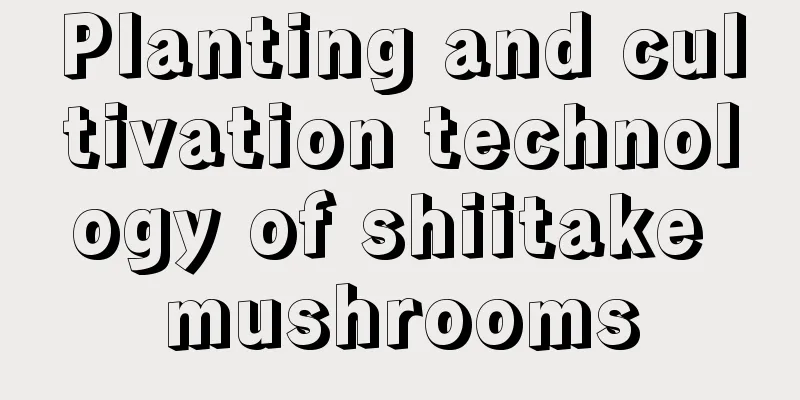Planting and cultivation technology of shiitake mushrooms

|
As an edible fungus, the cultivation of shiitake mushrooms must first start with the preparation of the strains. After determining the appropriate planting season, the next step is to select and prepare the culture medium. After the culture medium has been fermented, it can be put into bags and inoculated with holes. Let’s learn about the planting and cultivation techniques of shiitake mushrooms. 1. Preliminary preparation Site selection and ridge cultivation: Choose mountain fields with good ecological environment, fresh air, pure water and no pollution sources. It is best to have an east-west orientation, flat terrain, easy drainage and irrigation, and convenient transportation. Avoid sites that are susceptible to hail and flooding. Choose the appropriate ridge cultivation method according to the terrain. Low ridges should be made on high terrain or sloping land, while flat ridges or high ridges should be made on low-lying land. Mushroom bag production: Formula 1: 79% poplar sawdust, 20% wheat bran, 1% gypsum, 0.1% carbendazim (50% wettable powder ). Recipe 2: 45% corn cobs (crushed to the size of broad beans), 40% poplar sawdust, 13% cornmeal , 1% gypsum, 1% lime powder, 0.1% carbendazim (50% wettable powder). Make sure the sawdust is aged for more than half a year and the wheat bran is fresh and free of mold. Mixing materials: Mix sawdust, wheat bran and gypsum, stir 4-5 times, spray carbendazim and lime water into the dry material, and add water to the moisture content of about 60%. Bagging: Use polyethylene film, large bag 25×55 cm, medium bag 17-20×55 cm. When bagging, ensure that there is no air leakage and the bag is moderately tight. 2. Sterilization Earthen steamer production: Use a 1.5-meter diameter iron pot with an inner diameter of 2×2×2.5 meters and a volume of 8-10 cubic meters. Add water to the pot until the curtain is 20 cm high, cover the curtain with sack, and make the pot cover with 1.5 mm galvanized sheet . Add water and fill the pot: Add water to the pot, place the material bags neatly, and proceed in batches. Sterilization process: Heat to 100℃ over high heat, maintain for 10 hours, simmer overnight, remove from heat when material temperature drops to 70℃, and cool rapidly. 3. Vaccination Disinfection: Tools should be sealed and disinfected 4 days in advance, using sulfur fumigation. Inoculation time: When the temperature of the bag drops to 30℃, preferably in the morning or evening. Inoculation process: 4 people are responsible for drilling holes, taking out the fungus, mixing bags, tying the bags, and stacking. Fungal culture: dim light, room temperature 25℃, puncture holes after 16-20 days, gradually deepening the holes. 4. Mushroom production management Inducing mushroom growth: Stop watering for 4-5 days after the color change period, and alternate between dry and wet conditions to induce mushroom growth. Early management: From May to early June, strengthen ventilation, prevent rain, and reduce humidity. Mid-term management: From late May to late July, lower the temperature to promote fruiting body growth. Post-management: From late August to the end of September, prevent tube rot and mushroom rot. 5. Remove the bag and change the color and cover the soil Removing bags: After 90-110 days, cut the bags open with a blade and spread them flat on the bed surface. Mushroom bed disinfection: spray bleach or lime water, spray copper sulfate. Color change: Remove the film after 3 days, ventilate, rinse, and maintain 18-22℃. Covering soil: Use topsoil, mix in lime powder or burnt soil, and cover the mushroom tube. 6. Management during the fruiting period Mushroom shed: Use existing shed or build a new one, facing sunny and sheltered from wind, in dry terrain. Mushroom bag arrangement: horizontal row, bag spacing 4 cm, 42-44 bags per layer. Variable temperature mushroom cultivation: the temperature difference between day and night is more than 10℃, and the humidity is maintained at 85%. 7. Harvest Remove the inferior and keep the good: thin out the mushrooms appropriately and keep a uniform distance. Harvesting: Sell fresh or make into dried products. After harvesting, let the mushroom tubes rest and grow fungi. The above is an introduction to the key points of shiitake mushroom cultivation. If you want to grow shiitake mushrooms, you must first have a suitable cultivation area.
|
<<: How to sow peach blossoms?
>>: When can peach blossom cuttings take root? Can peach blossoms be propagated by cuttings?
Recommend
Why do plum blossoms drop leaves?
1. The temperature is too high 1. Reason: Plum bl...
The causes and treatments of yellow leaves of roses
1. Flower soil reasons 1. Reason: The yellow leav...
Peony Meaning
1. Meaning Peony is the national flower of my cou...
What is the flower language of cornflower?
Flower Language Flower Language The flower langua...
How to grow roses in pots and what to pay attention to
Growth habits of roses in pots Roses prefer place...
What to do if the core of the cymbidium orchid leaves turn yellow
1. Yellowing caused by poor lighting Cymbidium is...
Does Guanghan Palace use large or small basins?
Does Guanghan Palace use large or small basins? I...
Potato planting time and method planting method steps
Potato planting time The planting time for potato...
Sweet potato planting methods and management
Sweet potatoes are widely favored by people of al...
How to grow potted strawberries
The best time to buy strawberry seedlings is usua...
Things to note when repotting vinca rosea: root pruning, watering, and maintenance are also important
Precautions for repotting Catharanthus roseus The...
How many days does it take for wheat to sprout?
Wheat is an important cereal crop. Its growth cyc...
What fertilizer can make garlic grow big and high yield (the best fertilizer for growing garlic)
Shandong garlic is famous both at home and abroad...
How long does it take for jasmine cuttings to take root?
1. How long does it take to take root? It usually...
Cultivation methods and precautions of love vine
If the love vine is well cared for, some tubers w...









